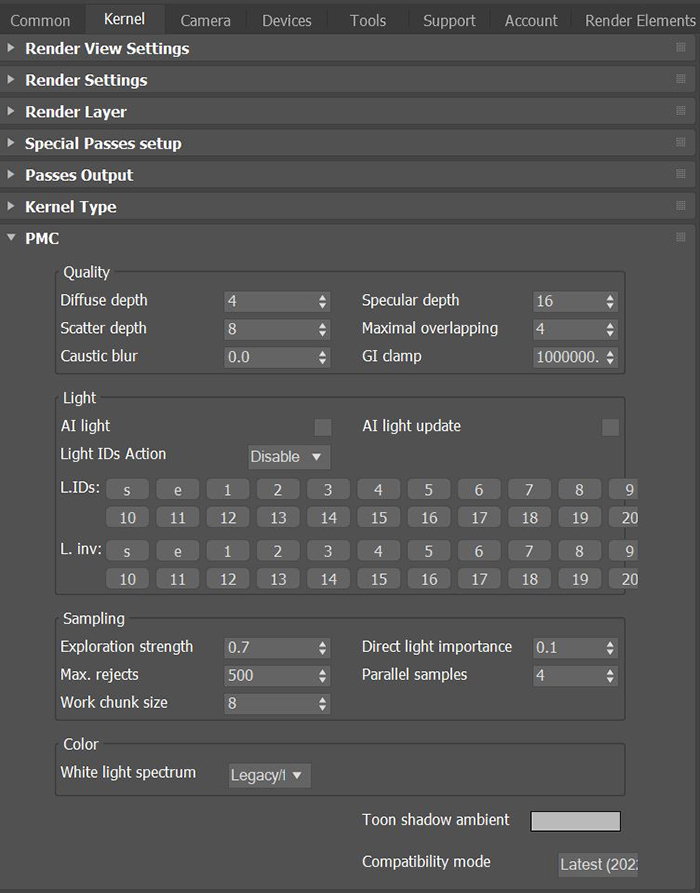PMC
The PMC kernel is a custom mutating unbiased kernel written for GPUs. It lets OctaneRender® resolve complex caustics and lighting.
|
|
PMC Kernel
|
Figure 1: The PMC kernel parameters
PMC Kernel Parameters
Quality
Diffuse Depth - The maximum number of times a ray bounces, reflects, or refracts on a surface with high Roughness or Diffuse settings. Higher values mean slower render speeds, but more realistic results. For outdoor scenes, set this parameter to around 4. For lighting interiors with natural light, use settings of 8 or higher. While high values are possible, in reality, rays won't go beyond 16 ray bounces.
Specular Depth - Determines the maximum path depth for specular reflections and refractions.
Scatter Depth - The maximum path depth to allow scattering.
Maximal Overlapping - Determines how much space to allocate for overlapping volumes. Ray marching is faster with low values but artifacts can be present where volumes overlap.
Caustic Blur - Higher values result in less caustic noise.
GI Clamp - Clamps each path's contribution to the specified value. Reducing this value can reduce the amount of fireflies caused by sparse but very strong contributing paths. Reducing this value also reduces noise by removing energy.
Light
AI Light - Enables AI lights. AI light functionality learns from the scene, and rendering becomes more efficient as more samples are rendered. When used with Adaptive Sampling, AI Light becomes even more effective as it learns pixel and light importance in a scene, and some pixels are no longer sampled.
AI Light Update - Enables dynamic updates to the AI lighting.
Light IDs Action - Determines whether the L.IDs (Light IDs) and L. Inv (Light Inverse) buttons enable or disable lights with matching Light Pass ID numbers.
Sampling
Exploration Strength - Determines strength for investigating accurate PMC paths.
Direct Light Importance - Makes the kernel focus more on paths with indirect light. For example, imagine sunlight through a window, which creates a bright spot on the floor. If Direct Light Importance is set to 1, the kernel focuses its sampling on this area. If Direct Light Importance is reduced, the kernel reduces its efforts to sample that area, and focuses more on more tricky areas that are harder for light rays to reach.
Max Rejects - Controls the render's bias. Reducing the value creates more biased results along with shorter render times.
Parallel Samples - Controls how many samples OctaneRender® calculates in parallel. Small values require less memory to store the sample's state, but renders are slower. High values use more graphics memory, and renders are faster. The change in performance depends on the scene, the GPU architecture, and the number of shader processors on the GPU.
Work Chunk Size - The number of work blocks done per kernel run. Increasing this value also increases the memory requirement on the system, but it does not affect memory usage, and may increase render speed.
Color
White Light Spectrum - Controls the appearance of colors produced by spectral emitters. This value determines the spectrum that will produce white in the final image. The D65 setting will produce a reasonable daylight color. The Legacy/Flat setting will preserve the appearance of legacy projects where the spectral emitters appear more blue.
Toon Shadow Ambient - Modifies the shadow ambient for toon shading.
Compatibility Mode - The Octane version that the behavior of this node should match.
- Latest (2022.1) - Default
- 2021.1 - Volume tracing behavior from versions 2018.1 to 2021.1 is used.
- 2021.1 (with 4.0 volumes) - Volume tracing behavior from version 4.0 and earlier is used.
- 2018.1 - Volume tracing behavior from versions 2018.1 to 2021.1 is used. Original pipeline for converting colors to and from spectra and for applying white balance is used (textures with colors outside of sRGB gamut will be rendered inaccurately).
- 4.0 - Volume tracing behavior from version 4.0 and earlier is used. Original pipeline for converting colors to and from spectra and for applying white balance is used (textures with colors outside of sRGB gamut will be rendered inaccurately).

